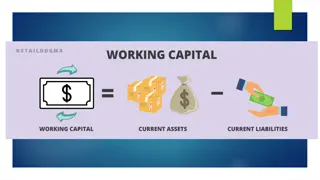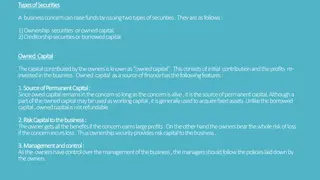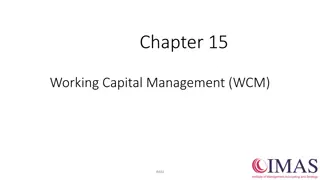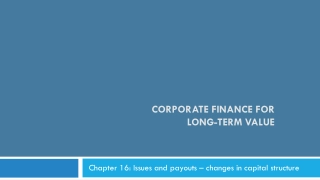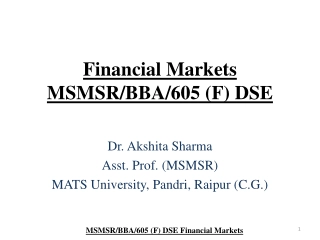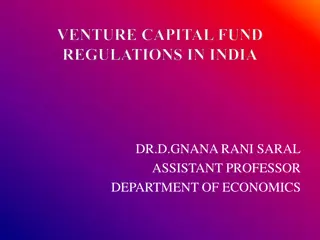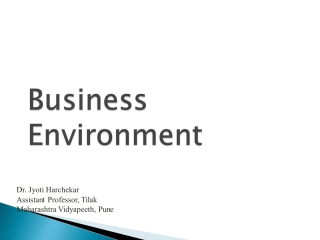Factors Influencing Working Capital Management
Factors influencing working capital include the nature and size of the business, demand of creditors, cash requirements, time for manufacturing goods, volume of sales, terms of purchases and sales, and the business cycle. The nature of the company, creditor demands for security, cash needs, and the level of sales directly affect the amount of working capital required. Understanding these factors is crucial for effective working capital management.
Download Presentation

Please find below an Image/Link to download the presentation.
The content on the website is provided AS IS for your information and personal use only. It may not be sold, licensed, or shared on other websites without obtaining consent from the author. Download presentation by click this link. If you encounter any issues during the download, it is possible that the publisher has removed the file from their server.
E N D
Presentation Transcript
Factors Determining Working Capital Factors Determining Working Capital The following factor determine the amount of working capital 1. Nature of Companies: The composition of an asset is a function of the size of a business and the companies to which it belongs. Small companies have smaller proportions of cash, receivables and inventory than large corporation. This difference becomes more marked in large corporations. Apublic utility, for example, mostly employs fixed assets in its operations, while a merchandising department depends generally on inventory and receivable. Needs for working capital are thus determined by the nature of an enterprise. 2. Demand of Creditors: Creditors are interested in the security of loans. They want their obligations to be sufficiently covered. They want the amount of security in assets which are greater than the liability.
3. Cash Requirements: Cash is one of the current assets which are essential for the successful operations of the production cycle. Aminimum level of cash is always required to keep the operations going.Adequate cash is also required to maintain good credit relation. 4. Nature and Size of Business: The working capital requirements of a firm are basically influenced by the nature of its business. Trading and financial firms have a very less investment in fixed assets, but require a large sum of money to be invested in working capital. Retail stores, for example, must carry large stocks of a variety of goods to satisfy the varied and continues demand of their customers. Some manufacturing business, such as tobacco manufacturing and construction firms also have to invest substantially in working capital and a nominal amount in the fixed assets.
5. Time: The level of working capital depends upon the time required to manufacturing goods. If the time is longer, the size of working capital is great. Moreover, the amount of working capital depends upon inventory turnover and the unit cost of the goods that are sold. The greater this cost, the bigger is the amount of working capital. 6. Volume of Sales: This is the most important factor affecting the size and components of working capital. A firm maintains current assets because they are needed to support the operational activities which result in sales. They volume of sales and the size of the working capital are directly related to each other. As the volume of sales increase, there is an increase in the investment of working capital-in the cost of operations, in inventories and receivables.
7. Terms of Purchases and Sales: If the credit terms of purchases are more favourable and those of sales liberal, less cash will be invested in inventory. With more favourable credit terms, working capital requirements can be reduced. A firm gets more time for payment to creditors or suppliers. A firm which enjoys greater credit with banks needs less working capital. 8. Business Cycle: Business expands during periods of prosperity and declines during the period of depression. Consequently, more working capital required during periods of prosperity and less during the periods of depression.
9. Production Cycle: The time taken to convert raw materials into finished products is referred to as the production cycle or operating cycle. The longer the production cycle, the greater is the requirements of the working capital. An utmost care should be taken to shorten the period of the production cycle in order to minimize working capital requirements. 10. Liquidity and Profitability: If a firm desires to take a greater risk for bigger gains or losses, it reduces the size of its working capital in relation to its sales. If it is interested in improving its liquidity, it increases the level of its working capital. However, this policy is likely to result in a reduction of the sales volume, and therefore, of profitability. A firm, therefore, should choose between liquidity and profitability and decide about its working capital requirements accordingly.
11. Seasonal Fluctuations: Seasonal fluctuations in sales affect the level of variable working capital. Often, the demand for products may be of a seasonal nature. Yet inventories have got to be purchased during certain seasons only. The size of the working capital in one period may, therefore, be bigger than that in another.






